Mammals of the Adirondacks:
Raccoon (Procyon lotor)
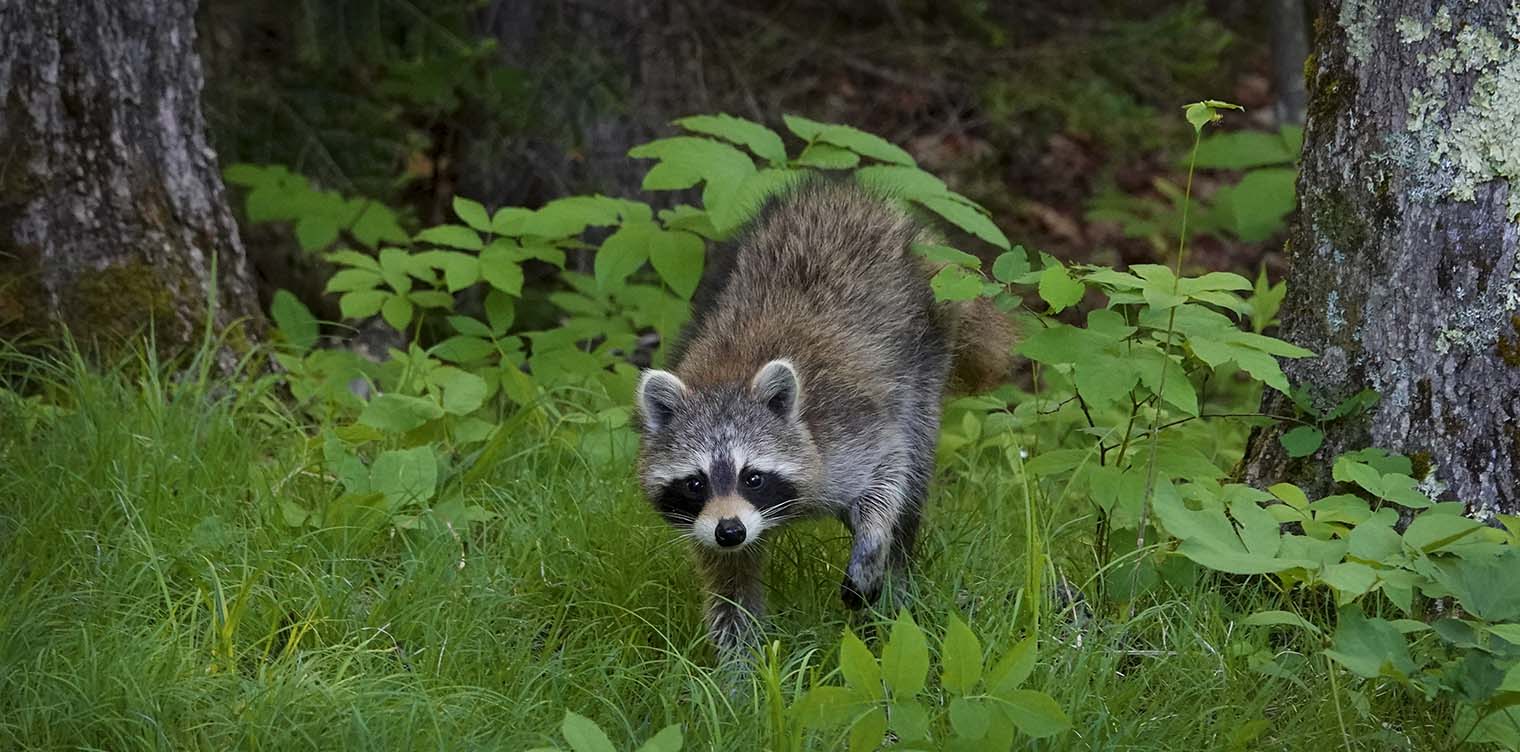
The Raccoon (Procyon lotor) is a medium-sized mammal with a bushy tail and distinctive facial mask. It is found throughout the Adirondack Park in a wide variety of habitats.
- The Raccoon is part of the order Carnivora, which also includes other species that make their home in the Adirondack Park, such as the Eastern Coyote, Gray Fox, and North American River Otter. The Raccoon is the only member of the family Procyonidae found in the Adirondacks.
- The Raccoon's genus name (Procyon) is derived from a combination of two Greek words: pro (meaning "before") and kyon (meaning "dog") – an apparent reference to the early notion that the Raccoon's ancestral stock also gave rise to dogs. The species name lotor is derived from a Latin word meaning "washer." This name apparently derives from the observation that captive Raccoons wet their food before eating.
- The nonscientific name is derived from an Algonquian term meaning: "he who scratches with his hands." Other nonscientific names for this species include Common Raccoon and Northern Raccoon.
The Integrated Taxonomic Information System database lists 22 subspecies of Raccoons. Ours is Procyon lotor lotor (Eastern Raccoon).
Raccoon: Description
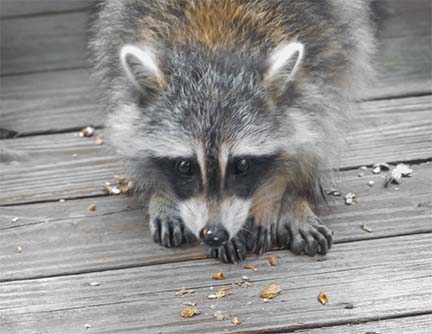
The Raccoon is a short-bodied, medium-sized mammal. It has short legs compared to its torso, giving it a rather stocky appearance. Adult Raccoons measure about 24 to 38 inches, including the bushy tail. Body weight varies significantly with habitat, but the common weight is between 15 and 28 pounds. Raccoons in the northern parts of their range weigh more than those in the south. Males weigh 15-20% more than females.
The most distinctive aspect of the Raccoon's appearance is its characteristic black facial mask, which extends from cheeks to eyes. Its head is broad with a slender muzzle, black nose. The prominent ears are bordered by white fur.
The Raccoon's fur is thick and coarse, with a dense underfur. Most Raccoons are iron gray, often with a brownish or reddish tinge on the nape of the neck. Many of the hairs are tipped with black. The Raccoon's under parts are pale. Its bushy tail is cylindrical and has five to seven dark bands. The Raccoon sheds its winter coat during the spring; its summer coat is thinner, with shorter hairs. In the fall, the animal grows a thick underfur and new guard hairs to prepare for the cold weather of winter.
The Raccoon's paws have five slender digits, with no webbing between them. The toes have sharp claws and naked soles. The claws are recurved, but not retractile. Raccoons can rotate their hind paws backwards 180 degrees, allowing them to descend trees head first. The Raccoon's front paws are highly sensitive, giving the animal an exceptional sense of touch.
Raccoons have a reputation for a high level of curiosity and intelligence – an attribute that presumably is part of the explanation for their wide distribution.
- A 1908 study summarizing a series of experiments on the Raccoon’s ability to open locks found that that the animals were able to retain their skills at opening simple fastenings for more than a year.
- Several other studies of Raccoon memory indicate that they can recall solutions to tasks for at least three years.
- A 2017 study which measured the number of neurons in the brains of carnivores found that Raccoons have a relatively small brain, but about as many neurons as would be expected in a primate.
Raccoon: Diet
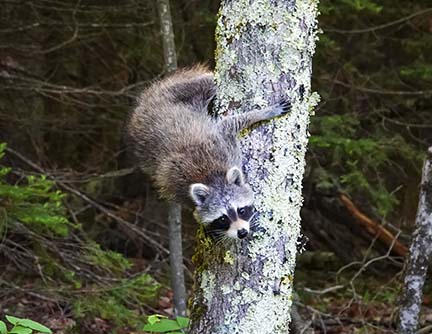
The Raccoon is an omnivore Omnivore: Animals that eats both plant- and animal-derived food. Carnivores (meaning "meat-eaters" in Latin) are animals that feed on other animals; obligate carnivores (such as members of the cat family) rely entirely on animal flesh, while facultative carnivores supplement their diets with non-animal foods. Herbivores feed exclusively on plants, although some may supplement their diets with small amounts of insects or other animals. , meaning that it consumes both plant and nonplant material. Raccoons feed mainly at night, with peak feeding activity generally occurring before midnight. Raccoons are selective when food is abundant, but will eat whatever they can find when it is scarce. Raccoons in urban and suburban locations often subsist by raiding garbage and garden crops.
Plant foods on the Raccoon menu include nuts (especially acorns and beech nuts), fruit (such as apples, wild cherries, and grapes), and grains. Animal foods include crayfish, insects, rodents (such as mice and voles), squirrels, snakes, frogs, and turtles and their eggs.
- Raccoons are documented or suspected nest predators of a wide variety of birds that breed in the Adirondacks, including Alder Flycatcher, American Kestrel, Bald Eagle, Barn Swallow, Barred Owl, Blue Jay, Chestnut-sided Warbler, Common Loon, Common Yellowthroat, Great Blue Heron, House Wren, Indigo Bunting, Mallard, Mourning Dove, Mourning Warbler, Ovenbird, Sandhill Crane, Song Sparrow, Tree Swallow, Wood Duck, Wood Thrush, and Yellow Warbler. For instance, researchers have estimated that 37-79% of nest failures of Common Loons is due to predation by Raccoons.
- Raccoons are also a major predator of Snapping Turtle nests. A 1980 study of Snapping Turtle nesting in northern New York found that predators destroyed 94% of the nests under study; 80% of those nests were plundered by Raccoons.
Raccoon diets vary widely, depending on season, habitat, and region. In spring and early summer, animal food is the major item on the menu, while fruits, grains, and seeds appear to predominate in summer, fall, and winter.
- A 1936 study of Raccoon fall and winter diets in western New York found that buckwheat, fruit, beechnuts, and acorns played an important part in Raccoon menus.
- A 1951 study of the stomach contents of Raccoons killed from April to early October in New York State found that both plant items (especially fruits and grains) and animal items (especially mammals and insects) played important roles in the Raccoon’s warm weather menu. Mammalian prey included voles, rabbits, Gray Squirrels, and chipmunks. Amphibians on the Raccoon’s menu included frogs and salamanders. Contrary to other studies, which found a heavy reliance on crayfish, no crayfish were recovered from the stomachs of these animals.
- A 1951 study of Raccoon scat in Minnesota found that crayfish, juneberries, grasshoppers, and acorns comprised a large part of Raccoon summer menus.
Raccoon: Reproduction and Family Life
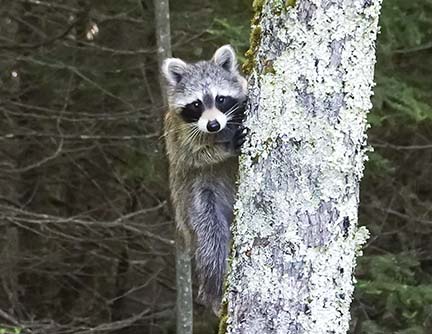
Female Raccoons begin breeding in their first or second year; males normally begin in their second year. The mating season is late winter or early spring. The timing apparently varies, depending on the region. After breeding, the pregnant female seeks out a den in which to bear her young, with the first choice being a hollow tree. However, underground burrows, rock crevices, and brush piles are also used.
The gestation period for Raccoons is about 63 days, with the young born in late April to early May. Mean litter sizes range from two to five, with larger litters in northern latitudes. Yearling females tend to produce smaller litters. An adult female usually produces a single annual litter.
The young Raccoons are lightly furred at birth and weigh in at about three ounces. Their eyes open at three weeks. They begin walking at four to six weeks. By seven weeks, they can generally walk, run, and climb. They will begin to eat solid food at about nine weeks, although they will continue to suckle for another month or so. The young are weaned at 12 to 16 weeks and will begin foraging with their mother by late summer. Male Raccoons play no direct role in rearing the young.
Some litters may disperse in the fall of their first year, but in the Adirondacks and most other northern parts of their range, young Raccoons remain with their mother for about a year, denning together in cold weather. They will disperse in spring when the mother's new litter arrives.
Raccoon: Behavior
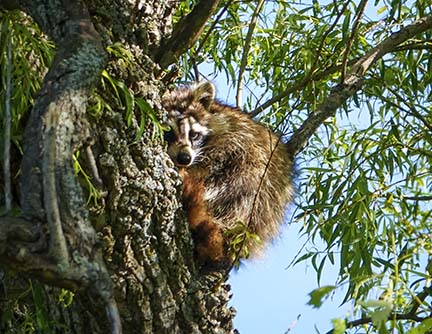
Activity Patterns:
Raccoons are nocturnal. They become active after sunset and remain active until dawn, with activity levels peaking before midnight. By sunrise or a few hours after, the Raccoon retires to a daytime resting site. In marshes or swamps, the resting site may be on the ground. Raccoons in the northern part of their range may also spend the day resting on tree limbs or on the tops of mashed-down Gray Squirrel nests.Unlike Woodchucks, who hibernate during the winter, Raccoons do not hibernate. and are active year-round in the southern parts of their range. However, in the Adirondacks and other northern latitudes, Raccoons enter into a winter dormancy which may last up to four months. The timing of the Raccoon's winter retreat appears to be triggered by both level of snow cover and temperature. Because the Raccoon's metabolic rate remains high, this period of winter retreat is not considered hibernation. The animal is easily aroused and may emerge during mild spells to forage. During this period, Raccoons rely for energy on fat supplies accumulated during the previous summer and fall, but may experience weight loss of up to 50%.
Social System:
Sources differ on the nature of the Raccoon's social organization. Some sources state that Raccoons are solitary except when breeding and that female Raccoons with their young and possibly sibling groups of the same sex are the only social units. The exceptions include times when individual Raccoons feed together at a concentrated food source (such as corn fields or garbage dumps) or when several individuals may den together in very cold weather.Other researchers who have studied Raccoon social structure suggest that Raccoons are not typically solitary. Unrelated males may form loose male social groups, while related females may share common areas and occasionally meet while feeding.
- A 2008 analysis of radio-collared Raccoons in southern Texas found that male Raccoons sometimes form stable groups of three to five members, forming social bonds that include resting together during the day and traveling as a pair or group at night.
- A 2011 study of Raccoon social structure in northeastern Illinois using proximity-detecting collars found that the social system of Raccoons is more complex than previously realized. This study documented the existence of male groups ranging in size from two to five animals, while over half of the females formed associations with other females during winter and spring.
Sources also conflict on the size and exclusivity of home ranges, suggesting that these factors probably vary widely depending on habitat and food availability. For instance, a 1978 study of the movements of radio-collared Raccoons in North Dakota found that female home ranges overlapped, but male home ranges did not. Adult males occupied home ranges exclusive of other males.
Communication:
Raccoons communicate through visual displays and a wide variety of vocalizations. A 1984 study of Raccoon vocalization conducted at the National Zoo’s Conservation and Research Center identified 13 call types, including whistles, squeals, screeches, cries, snorts, barks, growls, purrs, chitters, and grunts. During confrontations, Raccoons may use visual displays including tail lashing, baring of the teeth, and arching the back. This posturing may be accompanied by screams, hisses, snorts, or growls. Vocalizations between mother Raccoons and their young include purrs, twitters, chitters, and squeals.Raccoon: Mortality and Predators
Raccoons face a variety of predators. Mammalian predators include Eastern Coyotes, Fishers, Bobcats, and Red Foxes. Raccoons may also fall prey to Great Horned Owls. Human sources of mortality for Raccoons include hunting and motor vehicles.
- In New York State, Raccoons are one of ten species of furbearers that may be hunted; they may be hunted at any hour, day or night. Hunting season for Raccoons in our area is 25 October through 15 February, with no bag limits.
- Hunting or trapping Raccoons requires a license; however, unlicensed homeowners and farmers are permitted to destroy raccoons that damage property.
- Raccoons are not a particularly popular target of New York's small-game hunters. Statewide, an estimated 5,231 hunters participate in Raccoon hunting, with an estimated number of animals killed at 13,195. The most popular small game targets in terms of number of participants are Gray Squirrels and Fox Squirrels. Overall, the most popular game animal in the state is the White-tailed Deer, which faces more than 500,000 deer hunters per year.
Other sources of mortality for Raccoons include canine distemper (a common disease which is usually fatal) and rabies. Food shortages are also a significant cause of mortality. Many young Raccoons do not survive a full year, as they are vulnerable to starvation during severe winters.
As a result, the life expectancy of Raccoons in the wild is said to be only 1.8 to 3.1 years. The oldest estimated age for wild Raccoons is about 12 to 13 years. By contrast, captive Raccoons may live for up to twenty years or more.
Raccoon: Distribution
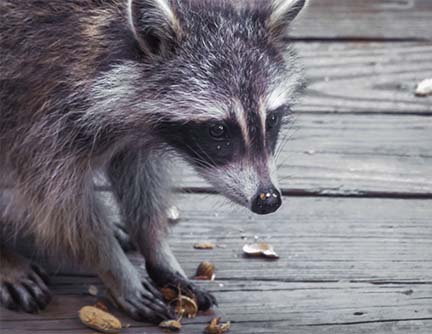
The Raccoon is one of the most abundant medium-sized omnivores in North America. Raccoons range from southern Canada to British Columbia, throughout the United States (except at higher elevations in the Rocky Mountains and deserts in the Southwest), and south throughout Mexico and Central America.
Raccoons are found throughout New York State, where they are among the most widespread mammals. Abundance varies widely, depending on habitat, with populations often more dense in large cities than in the countryside. Raccoon density in rural areas may be 20-40 animals per square mile; in developed regions (such as Long Island) Raccoon density may exceed 100 per square mile.
This pattern is reflected in the map of iNaturalist observations of Raccoons in New York State. Many of the 1,439 research-grade observations (as of early December 2020) for the state are clustered in city parks in urban areas, particularly New York City and western Long Island. There were only 17 research-grade observations of Raccoons in the Adirondack Park in early December. This compares to 183 research-grade observations of White-tailed Deer, 155 of Red Squirrel, and 147 of Eastern Chipmunk.
Raccoon Habitat
Raccoons are highly adaptable. Throughout its range, these animals are found in almost any plant community where water is available. Raccoon habitat includes hardwood forests, agricultural lands, marshes, and swamps. Raccoons are also common in suburban residential areas, abandoned farmland, and urban parks.
Within the Adirondack Park, Raccoons are at home in a variety of habitats, usually preferring sites near water. Favored habitat includes hardwood forests, marshes, and (to a lesser extent) mixed forests, as well as villages and hamlets. The species apparently avoids dense evergreen forests and is said to be uncommon or absent in conifer forests above 2500 feet.
Adirondack Mammal List
References
New York State Department of Environmental Conservation. Raccoon. Retrieved 25 November 2020.
New York State Department of Environmental Conservation. Furbearer Hunting. Retrieved 25 November 2020.
New York State Department of Environmental Conservation. Small Game Hunting. Retrieved 25 November 2020.
New York State Department of Environmental Conservation. Raccoon, Red & Gray Fox, Skunk, Opossum & Weasel Hunting Seasons. Retrieved 25 November 2020.
State University of New York. College of Environmental Science and Forestry. Raccoon. Procyon lotor. Retrieved 25 November 2020.
United States Environmental Protection Agency. Wildlife Exposure Factors Handbook. Office of Research and Development. EPA/600/R-93/187 (December 1993). pp. 233-245. Retrieved 17 January 2019.
Julie L. Tesky, Procyon lotor in Fire Effects Information System (FEIS). Species Reviews. Forest Service, Rocky Mountain Research Station, Fire Sciences Laboratory (United States Department of Agriculture, 1995). Retrieved 26 November 2020.
Joerg-Henner Lotze and Sydney Anderson, “Procyon lotor,” Mammalian Species, Number 119 (8 June 1979), pp. 1-8. Retrieved 26 November 2020.
Integrated Taxonomic Information System On-line Database. Procyon lotor. Retrieved 26 November 2020.
R., Timm, A.D., Cuarón, F., Reid, K. Helgen, and J.F. González-Maya, 2016. Procyon lotor. The IUCN Red List of Threatened Species. Retrieved 26 November 2020.
D. Andrew Saunders. Adirondack Mammals (Adirondack Wildlife Program. State University of New York. College of Environmental Science and Forestry, 1988 ), pp. 165-168.
William K. Chapman. Mammals of the Adirondacks. A Field Guide (North Country Books, 1991), pp. 100-101.
William J. Hamilton and John O. Whitaker, Jr. Mammals of the Eastern United States. Third Edition (Cornell University Press, 1998), pp.427-433. Retrieved 15 November 2020.
iNaturalist. Common Raccoon. Procyon lotor. Retrieved 26 November 2020.
iNaturalist. Adirondack Park Sightings. Common Raccoon. Procyon lotor. Retrieved 7 December 2020.
Alexander C. Martin, Herbert S. Zim, and Arnold L. Nelson. American Wildlife & Plants. A Guide to Wildlife Food Habits (Dover Publications, 1951), pp. 221-222. Retrieved 26 November 2020.
John Eastman. The Book of Forest and Thicket. Trees, Shrubs, and Wildflowers of Eastern North America (Harrisburg, Pennsylvania, 1992), pp. 52-55.
James M. Ryan. Adirondack Wildlife. A Field Guide (University of New Hampshire Press, 2008), pp. 207-208.
Donald W. Stokes and Lillian Q. Stokes. A Guide to Animal Tracking and Behavior (Little, Brown and Company, 1986), pp. 24-25, 62-63, 310-318.
Edward Claridge and Betty Ann Milligan. Animal Signatures (Nimbus Publishing, 1992), pp. 54-55.
James C. Halfpenny and Jim Bruchac. Scats and Tracks of the Northeast: A Field Guide to the Signs of Seventy Wildlife Species (Falcon, 2001), pp. 90-91.
Richard M. DeGraaf and Mariko Yamasaki. New England Wildlife: Habitat, Natural History, and Distribution (University Press of New England, 2001), p.146. Retrieved 26 November 2020.
Richard M. DeGraaf, Gretchin M. Witman, and Deborah D. Rudis. Forest habitat for Mammals of the Northeast (US Department of Agriculture. Forest Service, 1981), pp. 130-131. Retrieved 7 March 2020.
Stanley D. Gehrt, “Raccoon,” in George A. Feldhamer, Bruce C. Thompson, and Joseph A. Chapman (Eds). Wild Mammals of North America: Biology, Management, and Conservation. Second Edition (The Johns Hopkins University Press, 2003) pp. 611-634.
Olaus J. Murie. A Field Guide to Animal Tracks. Second Edition (Houghton Mifflin Company, 1974), pp. 37-40.
Allen Kurta. Mammals of the Great Lakes Region. Revised Edition. (University of Michigan, 1995), pp. 218-221. Retrieved 26 November 2020.
Rollin H. Baker. Michigan Mammals (Michigan State University Press, 1983), pp. 443-454. Retrieved 27 November 2020.
Clinton Hart Merriam. The Vertebrates of the Adirondack Region, Northeastern New York (Press of L.S. Poster, 1882), pp. 28, 91-95. Retrieved 2 March 2017.
Clinton Hart Merriam. The Mammals of the Adirondack Region, Northeastern New York (Self-published, 1884), pp. 91-91. Retrieved 2 March 2017.
Gerrit S. Miller, “Preliminary List of New York Mammals,” Bulletin of the New York State Museum, Volume 6, Number 29 (October 1899), pp. 273-390. Retrieved 15 November 2020.
Cornell Lab of Ornithology, Ithaca, New York. Birds of North America. Subscription Web Site. Alder Flycatcher, American Kestrel, Bald Eagle, Barn Swallow, Barred Owl, Blue Jay, Chestnut-sided Warbler, Common Loon, Common Yellowthroat, Great Blue Heron, House Wren, Indigo Bunting, Mallard, Mourning Dove, Mourning Warbler, Ovenbird, Sandhill Crane, Song Sparrow, Tree Swallow, Wood Duck, Wood Thrush, Yellow Warbler. Retrieved 16 November 2020.
Samuel I., Zeveloff. Raccoons: A Natural History (Smithsonian Institution Press, 2002). Retrieved 27 November 2020.
Edward A. Goldman. Raccoons of North and Middle America (US Department of the Interior. Fish and Wildlife Service. North American Fauna 60, 1950). Retrieved 28 November 2020.
Dorcas MacClintock. A Natural History of Raccoons (Scribner, 1981). Retrieved 27 November 2020.
W. J. Hamilton, Jr., “The Summer Food of Minks and Raccoons on the Montezuma Marsh, New York,” The Journal of Wildlife Management, Volume 4, Number 1 (January 1940), pp. 80-84. Retrieved 27 November 2020.
W. J. Hamilton, Jr., “The Food and Breeding Habits of the Raccoon,” Ohio Journal of Science, Volume 36, Issue 3 (May 1936), pp. 131-139. Retrieved 27 November 2020.
W. J. Hamilton, Jr., “Warm Weather Foods of the Raccoon in New York State,” Journal of Mammalogy, Volume 32, Number 3 (August 1951), pp. 341-344. Retrieved 27 November 2020.
Lyle J. Schoonover and William H. Marshall , “Food Habits of the Raccoon (Procyon lotor hirtus) in North-Central Minnesota,” Journal of Mammalogy, Volume 32, Number 4 (November 1951), pp. 422-428. Retrieved 27 November 2020.
Frederick W. Stuewer, “Raccoons: Their Habits and Management in Michigan,” Ecological Monographs, Volume 13, Number 2 (April 1943), pp. 203-257. Retrieved 28 November 2020.
Otto J. Sieber, “Vocal Communication in Raccoons (Procyon lotor),” Behaviour, Volume 90, Number 1/3 (August 1984), pp. 80-113. Retrieved 27 November 2020.
Stanley D. Gehrt, William F. Gergits and Erik K. Fritzell, “Behavioral and Genetic Aspects of Male Social Groups in Raccoons,“ Journal of Mammalogy, Volume 89, Number 6 (December 2008), pp. 1473-1480. Retrieved 27 November 2020.
Erik K. Fritzell, “Aspects of raccoon (Procyon lotor) social organization,”Canadian Journal of Zoology, Volume 56, Number 2 (February 1978), pp. 2610-271. Retrieved 25 November 2020.
Suzanne Prange, Stanley D. Gehrt, Stephanie Hauver and Christian C. Voigt, “Frequency and Duration of Contacts Between Free-ranging Raccoons: Uncovering a Hidden Social System,” Journal of Mammalogy, Volume 92, Number 6 (December 2011), pp. 1331-1342. Retrieved 27 November 2020.
Débora Jardim-Messeder, et al., “Dogs Have the Most Neurons, Though Not the Largest Brain: Trade-Off between Body Mass and Number of Neurons in the Cerebral Cortex of Large Carnivoran Species,” Frontiers in Neuroanatomy, Volume 11 (2017). Retrieved 30 November 2020.
H. B. Davis, “The Raccoon: A Study in Animal Intelligence,” The American Journal of Psychology, Volume 18, Number 4 (October 1907), pp. 447-489. Retrieved 2 December 2020.
